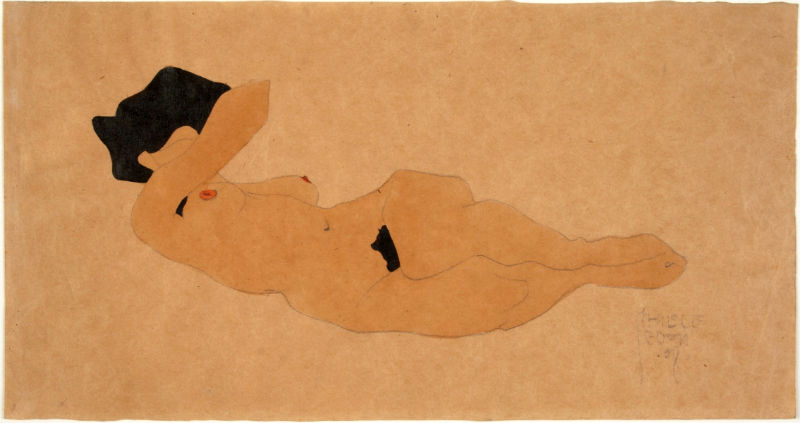Four emotionally charged works by Egon Schiele come to UMMA

University of Michigan Museum of Art’s Connector Gallery frequently displays new acquisitions to the public. Recently, UMMA received four works by early 20th-century Austrian artist Egon Schiele. These four works include pencil drawings and paintings that convey the unconventional figural style for which Schiele is well-known.
Schiele’s figural works make up the majority of his oeuvre, and these gifted artworks represent his investigations into the human figure, each featuring a nude female, sometimes posed with accessories such as jewelry, stockings, or shoes.
The four pieces were donated to UMMA's permanent collection by retired University of Michigan professors Frances McSparron and the late Ernst Pulgram. These four works by Schiele represent a small portion of UMMA's collection of Austrian and German Expressionist works, many of which the professors later donated to the museum.
Egon Schiele (1862-1918) was a pioneering artist of the early German Expressionist movement and a victim of the Spanish Flu pandemic, but he produced an enormous body of work before his untimely death. UMMA curator Laura De Becker points out that Schiele was able to produce more than 3,000 works over 10 years, making him one of the most prolific artists of the time. In addition to his intense level of productivity, his works influenced many celebrated artists such as Francis Bacon, Jean-Michel Basquiat, and Julian Schnabel.
De Becker describes Schiele’s artistic approach as “emotionally charged -- often unsettling and explicit -- figural studies, self-portraits, and nudes.” De Becker also points out that Schiele’s works are known for resisting “classical and conventional representations of the time.” Schiele was controversial in his lifetime, having been jailed for the content of his images, which were seen as too erotic or disturbing for public consumption.
Aside from his own signature style and frequent tendency to depict non-conventional subject matter, Schiele is known for studying under the iconic symbolist painter Gustav Klimt. Klimt’s work is easily among the most recognizable of the era, in part due to the success of the book The Lady in Gold and subsequent film Woman in Gold. Klimt’s influence can be seen in Schiele’s handling of negative spaces and pattern within his paintings.
Schiele’s handling of the human figure, however, is exceptional in his ability to twist and alter the subject’s proportions, manipulate the plane of the composition, create raw imagery, and deal unflinchingly with societally taboo themes that were just beginning to enter into fine art at the time. Schiele often represented subject matter and themes such as death, illness, and eroticism. He experimented by employing expressive line work that would soon be seen in the Abstract Expressionist movement in America and Europe decades later.
The four works on display represent Schiele’s unique approach to the nude figure, and offer insight into the development of later styles and movements in the art world.
Elizabeth Smith is an AADL staff member and is interested in art history and visual culture.
Four works by Egon Schiele are on display at UMMA through September 15.


































